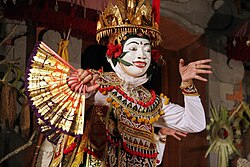 | |
| Native name | Saman Jejuntèn, Saman Njik, Saman Ngerje (Umahsara), Bejamu Besaman (Saman Sara Ingi, Saman Roa Lo Roa Ingi), Saman Bale Asam, Saman Pertunjukan |
|---|---|
| Genre | Traditional dance |
| Origin | Gayo Lues, Indonesia |
| Saman dance | |
|---|---|
| Country | Indonesia |
| Reference | 00509 |
| Region | Asia and the Pacific |
| Inscription history | |
| Inscription | 2011 (6th session) |
| List | Need of Urgent Safeguarding |
Saman (also known as the dance of a thousand hands) is one of the most popular dances in Indonesia. Its origin is from the Gayo ethnic group from Gayo Lues, Aceh province, Indonesia, and it is usually performed to celebrate important occasions. [1] The dance is characterized by its fast-paced rhythm and common harmony between dancers. These two elements are key figures of Saman and are among the reasons Saman is widely known and practiced in Indonesia, besides being relatively easy to learn.
Contents
On November 24, 2011, UNESCO officially recognized Aceh's traditional Saman dance as an Intangible Cultural Heritage in Need of Urgent Safeguarding. [2] [3] [4]
The ASEAN Tourism Association (ASEANTA) named the Saman dance as the best ASEAN cultural preservation effort at the 25th ASEANTA Awards for Excellence 2012. [5]


















